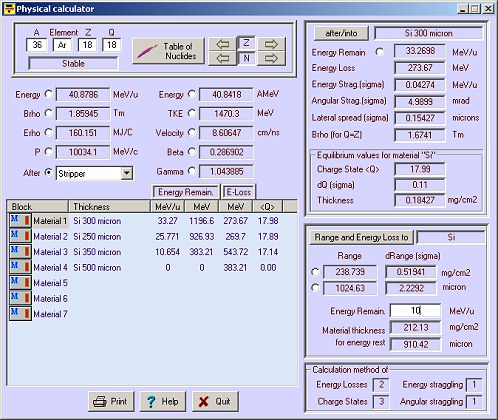|
|
NSCL,MSU, East Lansing, MI 48824-1321, USA
|
LISE++ is the new generation
of the LISE1) code, which allows the creation of a
spectrometer through the use of different “blocks”. A “block” can be a dipole
(dispersive block), a material (i.e. a given thickness for a detector), a piece
of beampipe, etc. The original LISE was restricted to a configuration
consisting of two dipoles, a wedge, and a velocity filter. The number of blocks
used to create a spectrometer in LISE++ is limited by operating memory of your
PC and your imagination. The code has an improved interface, new utilities were
added, and the spectrometer scheme in the program allows quick editing of
blocks (see Last Changes).








|
Powerful tool to prepare an experiment with secondary beam |
The program LISE called after the spectrometer of the same
name 2) has been developed
to calculate the transmission and yields of fragments produced and collected
in a fragment separator. Nowadays, projectile fragmentation is being used
worldwide in many laboratories to produce Radioactive Nuclear Beams. Being
able to predict as well as identify online the content of RNBs is therefore
of prime importance. This has guided the definitions of the main purposes
and characteristics of the program:
 Predict fragment separator settings to obtain a specific RNB; Predict fragment separator settings to obtain a specific RNB;
 Predict the intensity and purity of the chosen RNB; Predict the intensity and purity of the chosen RNB;
 Simulate identification plots to be compared online (see Fig.1); Simulate identification plots to be compared online (see Fig.1);
 Provide a highly userfriendly environment; Provide a highly userfriendly environment;
 Possibility to configure the program for different fragment separators. Possibility to configure the program for different fragment separators.

Fig.1. Plot of transmitted fragments
after magnetic rigidity filtering. The axes are the energy loss for the
ordinate and the time-of-flight for the abscissa. This plot and subsequent
identification plots are produced by a Monte-Carlo generator to better
mimic the experimental spectra observed on-line.
A statistical model 3,4)
is used to determine the momentum and angular phase space distributions
of the projectile fragments. The average fragment velocity can be set to
a constant value or can be calculated from the expressions given in the
code. The cross sections are calculated according to a global parameterization
EPAX 5) with no energy dependence. Four different built-in parameterizations
5,6) of cross sections based on the EPAX model and Geometrical
Abrasion-Ablation
model are available. It is also possible to directly enter the cross section
for a given reaction, provided it was previously measured or calculated
by more sophisticated codes. Once a cross section is manually entered in
the program it is automatically saved with the results of calculations.
The determination of the equilibrium charge state distribution
of an ion beam after passing through material can be calculated according
to three different parameterizations 7-9).The calculation of
charge state distributions and their corresponding transmissions can be
enabled or disabled by selecting the Charge States option. In case it is
enabled, the charge states of the fragment of interest have to be specified
after the target and the wedge.
The calculation
of energy loss and energy straggling is crucial for deducing magnetic rigidities,
transmission of fragments and their ranges in detectors. Two energy loss
calculation methods are available 10,11).
Energy losses are calculated for atomic numbers (1 =< Z =<
130) and energies from 10 keV in materials from Hydrogen up to Uranium.
The calculation of energy loss in gas and composite materials is also included.
built-in Energy loss, Time-of-Flight, Position, Angular, Charge, Cross-Section distribution
plots and dE-E, dE-TOF, Z-A/Q and dE-X two-dimensional plots allow to visualize
the results of the program calculations. An application of
transport integral 12) lies in the
basis of fast calculations of the program for the estimation of temporary
evolution of distributions of phase space.
In 1998 the program has undergone
a number of serious changes and has been adapted to the environment of "Windows"
 Being adapted to the 32-bit operating system «Windows»
the program has received an improved interface with which the user gets all opportunities of the given operating system (work in several windows,
drivers of a seal etc.); Being adapted to the 32-bit operating system «Windows»
the program has received an improved interface with which the user gets all opportunities of the given operating system (work in several windows,
drivers of a seal etc.);
 There appeared an opportunity to choose the parameterization
of fragmentation cross-sections and model the charge distributions of ions; There appeared an opportunity to choose the parameterization
of fragmentation cross-sections and model the charge distributions of ions;
 built-in database of nuclides has been added. It is
possible to see a transmission of a given isotope, its characteristics
and energy after second dipole clicking on an isotope of interest in the
table of nuclides by the right button of the mouse; built-in database of nuclides has been added. It is
possible to see a transmission of a given isotope, its characteristics
and energy after second dipole clicking on an isotope of interest in the
table of nuclides by the right button of the mouse;
 The optical parameters of the spectrometer are entered
as transport matrices that are more convenient. Initial angular, spatial
and energy emittances of beam are used; The optical parameters of the spectrometer are entered
as transport matrices that are more convenient. Initial angular, spatial
and energy emittances of beam are used;
 The new dipole after the Wien filter of velocities
has been added; The new dipole after the Wien filter of velocities
has been added;
 There appeared an opportunity to choose a degrader
profile (achromatic, monochromatic, homogeneous, user-defined) in the intermediate
dispersive focal plane. There appeared an opportunity to choose a degrader
profile (achromatic, monochromatic, homogeneous, user-defined) in the intermediate
dispersive focal plane.

Fig.2. Physical calculator window
showing various calculations performed for the nucleus 24O.
The energy can be entered not only by the different parameters such as
magnetic rigidity, velocity or momentum (radio buttons on the left), but
also by specifying either an energy after a given material (top right)
or the total range (bottom right).
 In
addition, several general purpose tools such as a physical parameters calculator
(see Fig.2), a scattering calculator, a database of nuclei properties,
and relativistic two body kinematics calculations make it also attractive
in experiments where radioactive beams are not involved. Most of the options
available in the program are well documented in an online help. The constant
improvements of the code based on the user's remarks has brought its high
flexibility and made it well adaptive to almost any nuclear physics experiment
using magnetic and/or electrostatic separation devices. With the advent
of the World Wide Web, it has become very easy to maintain and update the
program, and it can now be freely downloaded and installed at the addresses: In
addition, several general purpose tools such as a physical parameters calculator
(see Fig.2), a scattering calculator, a database of nuclei properties,
and relativistic two body kinematics calculations make it also attractive
in experiments where radioactive beams are not involved. Most of the options
available in the program are well documented in an online help. The constant
improvements of the code based on the user's remarks has brought its high
flexibility and made it well adaptive to almost any nuclear physics experiment
using magnetic and/or electrostatic separation devices. With the advent
of the World Wide Web, it has become very easy to maintain and update the
program, and it can now be freely downloaded and installed at the addresses:
References
1) O.Tarasov,D.Bazin, NIM B 266 (2008) 4657-4664;
D.Bazin, O.Tarasov, M.Lewitowicz, O.Sorlin, NIM A 482 (2002) 307-327.
2) R.Anne et al., NIM A257(1987)215.
3) A.S.Goldhaber, Phys.Lett.B53 (1974)306.
4) R.Dayras et al., Nucl.Phys. A460 (1986)299.
5) K.Summerer; et al., Phys.Rev. C42 (1990).2546; Phys.Rev. C61 (2000) 034607.
6) O.Tarasov et al., Phys.Lett. B409 (1997)64; Nucl.Phys. A.629 (1998)605.
7) J.Winger et al., NIM B70 (1992).380.
8) A.Leon et al., AD&NDT, 69 (1998)217.
9) K.Shima et al., NIM, 200 (1982) 605.
10) F.Hubert et al , AD&NDT, 46 (1990)1.
11) J.F.Ziegler et al., 'The Stopping
nd Range of Ions in Solids', Pergamon Press,
New York, 1985.
12) D.Bazin and B.Sherrill, Phys.Rev. E50 (1994)4017-4021.
|
|